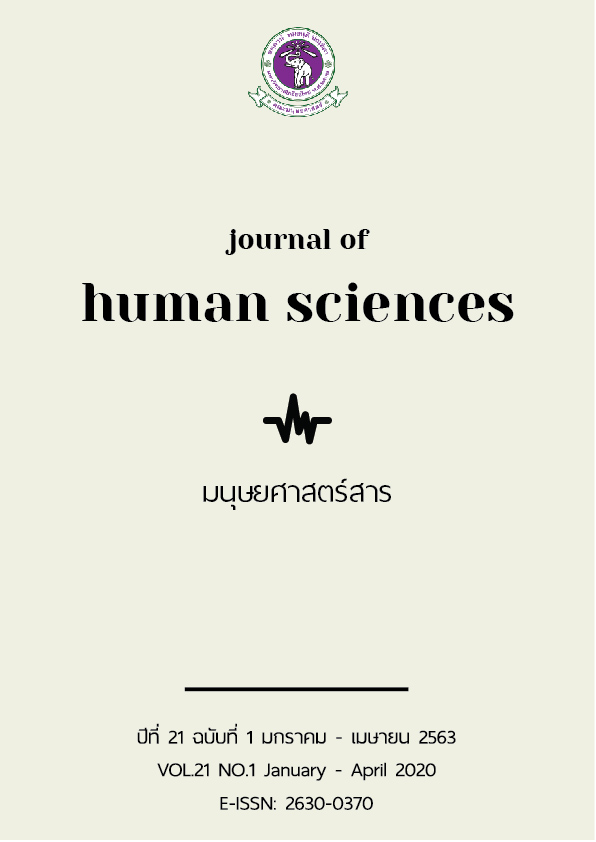ภาษาบนป้ายชื่อร้านค้าชาวไทยเชื้อสายจีนในเขตชุมชนเยาวราช กรณีศึกษาชื่อร้านค้าภาษาจีนและภาษาไทย
Main Article Content
บทคัดย่อ
บทความนี้เป็นการศึกษาภาษาบนป้ายชื่อร้านค้าชาวไทยเชื้อสายจีนในเขตชุมชนเยาวราช: กรณีศึกษาชื่อร้านค้าภาษาจีนและภาษาไทย มีวัตถุประสงค์เพื่อศึกษาแนวนิยมในการตั้งชื่อร้านค้าทั้งภาษาจีนและภาษาไทย รวมถึงศึกษาข้อมูลทางธุรกิจการค้าจากชื่อร้านค้าทั้งภาษาจีนและภาษาไทยของชาวไทยเชื้อสายจีนในเขตชุมชนเยาวราช จำนวน 290 ร้านที่มีทั้งชื่อภาษาไทยและภาษาจีน ใช้วิธีวิจัยเชิงคุณภาพและเชิงปริมาณ วิเคราะห์ข้อมูลและแสดงผลการวิจัยแบบตารางและพรรณนาวิเคราะห์ ผลการวิจัยพบว่า แนวนิยมในการตั้งชื่อร้านค้าทั้งภาษาจีนและภาษาไทยบนป้ายชื่อร้านค้าชาวไทยเชื้อสายจีนในเขตชุมชนเยาวราช ประกอบด้วย จำนวนพยางค์ ที่มาของคำและแหล่งที่มาจากชื่อร้าน สำหรับชื่อร้านค้าภาษาจีนบนป้ายชื่อร้านค้าชาวไทยเชื้อสายจีนในเขตชุมชนเยาวราช นิยมจำนวน 3 พยางค์มากที่สุด ที่มาของชื่อร้านค้าภาษาจีนนิยมภาษาจีนภาษาเดียว ส่วนแหล่งที่มาของชื่อร้านค้าเป็นแบบคำบอกชื่อสกุลมากที่สุด สำหรับชื่อร้านค้าภาษาไทยบนป้ายชื่อร้านค้าชาวไทยเชื้อสายจีนในเขตชุมชนเยาวราช นิยมจำนวน 3 พยางค์มากที่สุด ที่มาของชื่อร้านภาษาไทยนิยมภาษาไทยภาษาเดียวมากที่สุด ส่วนแหล่งที่มาของชื่อร้านค้าเป็นชื่อร้านค้าที่ตั้งขึ้นจากคำบอกชื่อสกุลมากที่สุด ข้อมูลทางธุรกิจการค้าจากชื่อร้านค้าทั้งภาษาจีนและภาษาไทยของชาวไทยเชื้อสายจีนในเขตชุมชนเยาวราช ผลการศึกษาพบว่า กลุ่มธุรกิจการค้าของชาวไทยเชื้อสายจีนในเขตชุมชนเยาวราชที่พบจากชื่อร้านค้ามากที่สุด คือ ร้านขายอาหารประเภทอาหารแห้งและอาหารสด ส่วนแซ่ของผู้ประกอบการชาวไทยเชื้อสายจีนในเขตชุมชนเยาวราชจากป้ายชื่อร้านค้าภาษาจีนมี “แซ่ลิ้ม”(林) มากที่สุด ประเภทธุรกิจที่ปรากฏมากที่สุดจากป้ายชื่อภาษาไทยและภาษาจีนของร้านค้าชาวไทยเชื้อสายจีนในเขตชุมชนเยาวราช คือ ประเภทธุรกิจแบบองค์กรธุรกิจจัดตั้ง ตัวอย่างเช่น ธุรกิจการให้บริการ ประกอบด้วยโรงแรม (大酒店、大旅社) ร้านอาหาร (酒家、酒樓、飯店、酒樓、飯店、餐室) บริษัทท่องเที่ยว(旅行社) ธุรกิจการเงิน (银行、餉當) และธุรกิจอาหาร (點心、餃子、燕窩) เป็นต้น การศึกษาครั้งนี้สะท้อนให้เห็นว่า ภาษาบนป้ายชื่อร้านค้าชาวไทยเชื้อสายจีนในเขตชุมชนเยาวราช สะท้อนแนวนิยมในการตั้งชื่อร้านค้า เป็นข้อมูลสะท้อนเชิงภาษา ประวัติศาสตร์ชาวไทยเชื้อสายจีน ระบบชื่อและตระกูลแซ่ และข้อมูลเกี่ยวกับธุรกิจในเขตชุมชนเยาวราช
Article Details
เอกสารอ้างอิง
Aksara, Y. (2001). Kin aroi yan Yaowarat [Delicious Meal at Yaowarat]. Bangkok: Saengdaet.
Chantavanich, S. (2006). Sam pheng: prawattisat chumchon chaochin nai Krungthep [Sampeng: History of Chinese Community in Bangkok]. Bangkok: Chinese Studies Center Institute of Asian Studies, Chulalongkorn University.
Chongbanchop, W. (1991). Kansuksa phasa thi chai nai kan tang chu thurakit kankha [A study of Language use in Language use in naming business enterprises]. (Master’s thesis, Thammasat University).
Jingsi, N. (2018). Laksana kanchai phasa khong chu rankha Yaowarat [Language usage of commercial names of business in Yaowarat area]. (Master’s thesis, Huachiew Chalermprakiet University).
Khumtong, N. (2014). Kan plianplaaeng kan tang chur rankha yan Sampheng [A Study of Change in Business naming in Sampeng area]. (Master’s thesis, Thammasat University).
Kririmek, L. (1998). Naeo niyom nai kan tang chu rankha nai khet thetsaban Nakhon Khonk kaen [The Popularization of Naming Shops in the Area of Nakhon Khon Khaen Municipality]. (Master’s thesis, Mahasarakham University).
Kumdet, P. (2001). Thurakit anyamani læ khruangpradap [Gem and Jewelry business]. Bangkok: Surawatpress.
Lophetrat, K. (2017). Tam nan luk lan mang korn nai phanedin siam [the region of Dragon Descendants in Siam]. Bangkok: lukbathasibsee.
Luangthongkam, T. (2004). Sap tha nu krom ahan Yaowarat [Yaowarat Street food glossary]. Bangkok: Chulalongkorn University.
Luk Suea No.9. (2007). Ratee tee Yaowarat [the night in Yaowarat]. Retrieved from http://www.okanation.Net / blog/chai/2007/10/06/entry-3.
Pikulthong, S. (2011). phasa bon pai phanit khong sathanprakopkan yan thanon phra athit [Languages on commercial signs along Phraathit Road, Bangkok]. Damrong Journal, 10(2). 65-85.
Piller, I. (2003). Advertising as a site of language contact. Annual Review of Applied Linguistics, 23(3). 170-183.
Sangsawang, P. (2002). Kansuksa chu rankha thurakit khong khon Thai chuasaichin tam næo phasasat: korani suksa khet samphanthawong krung thep maha nakhon [A Linguistic of the trading business names of the Chinese Thais: A case study in Samphanthawong District, Bangkok]. (Master’s thesis, Mahidol University).
Skinner, G. (2005). Chinese Society in Thailand. Bangkok: greenprint.
Sodsonghrit, M. (2012). Kansamruat lae suksa wikhro chu rankha phasa chin khong chao thai chuasaichin nai khet amphoe muang changwat Ubon ratchathani [A survey and analysis of the trade name in Chinese Thais merchant shop and stores in Muang District, Ubon Ratchathani Province]. Journal of Liberal Arts, Ubon Ratchathani University, 8(2). 63-89.
Sukhkasame, R. (2001). Phasa thi chai nai kan tangchur thurakit phaninai khet thetsaban nakhon hat yai amphoe hat yai changwat songkhla [Language use in naming business enterprises in Haadyai metropolitan municipality, Haadyai District, Songkhla Province]. (Master’s thesis, Thaksin University).
Sun prawattisat Yaowarat [Yaowarat Chinatown Heritage Center]. (2018). Retrieved from https://www.bangkokriver.com/th/place/yaowarat-chinatown-heritage-center/
Thangkrathok, et al. (2017). Raingan kanwichai ruang næothang kan songsæem kanthongthieo chæng wantthanatham yan Yaowarat [Guidelines to Promote the Cultural Tourism in Yaowarat District]. Bangkok: Rajamangala University of Technology Rattanakosin.
Thongsem, P. (2014). lot rua Yaowarat. [Pass Through Yao-wa-raj]. Thammasat Review, 33(2). 175-186.


